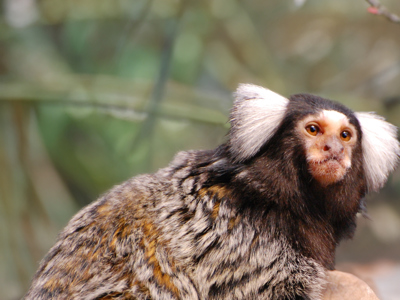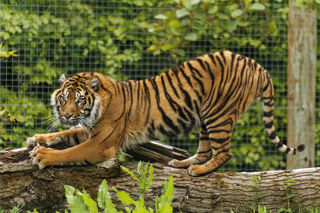
Common marmoset
Common marmosets are New World monkeys, a term describing monkeys from South and Central America. They have white tufts of hair on the sides of their heads and on their forehead which identify them as common marmosets. Like all marmosets and tamarins they have claws on their fingers (though they still have nails on their thumbs) rather than the nails common to all other primates. This helps them grip the bark of the trees they climb.

They live in polyandrous groups of 3-13, which means that a single female mates with multiple males who fluidly enter and leave the group. Typically the core of the group will have one female, a male and their offspring. All members of the group assist with parental care. At birth the twin infants will be 40% of the mother’s weight and it is thought that the polyandry evolved to ensure that there was enough parental support to successfully rear the energy hungry infants.

Like all marmosets, common marmosets eat a diet high in tree sap and have specialised teeth to access this food type. Common marmosets will also eat a range of plants and animals including flowers, nectar, fruit, insects and spiders. They will also take small lizards, frogs and birds eggs.
The common marmoset is widespread and the population is stable. However, habitat destruction is still a significant threat. Unlike many other marmoset and tamarin species, poaching for the pet trade is of fairly small concern.
Key Facts:
Conservation Status: Least Concern
Distribution: Brazil
Habitat: Tropical Forest
Diet: Animals, Fruit, Gum, Insects, Leaves
Height: 15 – 20cm
Weight: 300 – 500g
Gestation: 148 days
No. of young: 2
Life Span: 16 years

SUPPORT OUR ANIMALS
If you're looking for an alternative way to donate to Twycross Zoo, you can help support our animals and our zoo keepers by purchasing something from our Amazon Wishlist!
Updated regularly by our zoo keepers, the items on the list help to provide enrichment for our animals and keep their habitats well maintained.
Every donation helps us as a conservation charity.

